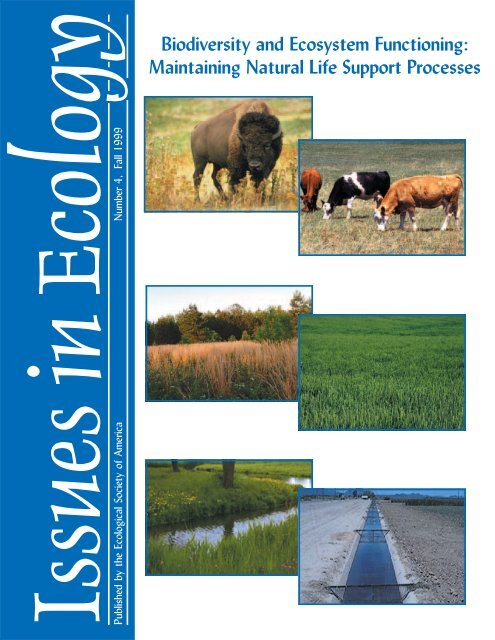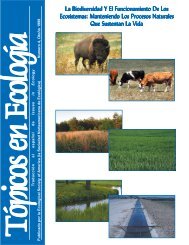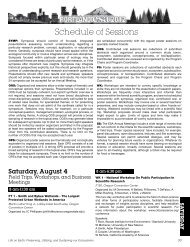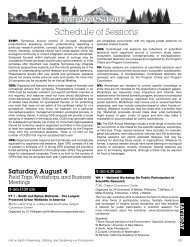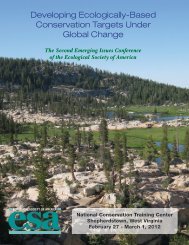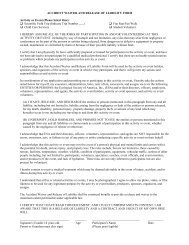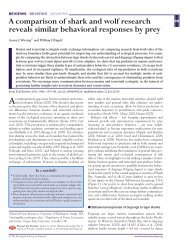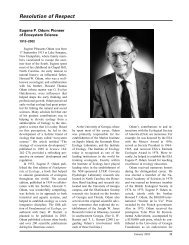Biodiversity and Ecosystem Functioning - Ecological Society of ...
Biodiversity and Ecosystem Functioning - Ecological Society of ...
Biodiversity and Ecosystem Functioning - Ecological Society of ...
Create successful ePaper yourself
Turn your PDF publications into a flip-book with our unique Google optimized e-Paper software.
Issues in Ecology<br />
Published by the <strong>Ecological</strong> <strong>Society</strong> <strong>of</strong> America Number 4, Fall 1999<br />
<strong>Biodiversity</strong> <strong>and</strong> <strong>Ecosystem</strong> <strong>Functioning</strong>:<br />
Maintaining Natural Life Support Processes
Issues in Ecology Number 4 Fall 1999<br />
<strong>Biodiversity</strong> <strong>and</strong> <strong>Ecosystem</strong> <strong>Functioning</strong>:<br />
Maintaining Natural Life Support Processes<br />
by<br />
Shahid Naeem, Chair, F.S. Chapin III, Robert Costanza, Paul R. Ehrlich, Frank B. Golley, David U. Hooper,<br />
J.H. Lawton, Robert V. O’Neill, Harold A. Mooney, Osvaldo E. Sala, Amy J. Symstad, <strong>and</strong> David Tilman<br />
Critical processes at the ecosystem level influence plant productivity, soil fertility, water quality,<br />
atmospheric chemistry, <strong>and</strong> many other local <strong>and</strong> global environmental conditions that ultimately<br />
affect human welfare. These ecosystem processes are controlled by both the diversity <strong>and</strong> identity <strong>of</strong><br />
the plant, animal, <strong>and</strong> microbial species living within a community. Human modifications to the living<br />
community in an ecosystem – as well as to the collective biodiversity <strong>of</strong> the earth – can therefore alter<br />
ecological functions <strong>and</strong> life support services that are vital to the well-being <strong>of</strong> human societies.<br />
Substantial changes have already occurred, especially local <strong>and</strong> global losses <strong>of</strong> biodiversity. The<br />
primary cause has been widespread human transformation <strong>of</strong> once highly diverse natural ecosystems<br />
into relatively species-poor managed ecosystems. Recent studies suggest that such reductions in<br />
biodiversity can alter both the magnitude <strong>and</strong> the stability <strong>of</strong> ecosystem processes, especially when<br />
biodiversity is reduced to the low levels typical <strong>of</strong> many managed systems.<br />
Our review <strong>of</strong> the available evidence has identified the following certainties concerning biodiversity<br />
<strong>and</strong> ecosystem functioning:<br />
• Human impacts on global biodiversity have been dramatic, resulting in unprecedented losses<br />
in global biodiversity at all levels, from genes <strong>and</strong> species to entire ecosystems;<br />
• Local declines in biodiversity are even more dramatic than global declines, <strong>and</strong> the beneficial<br />
effects <strong>of</strong> many organisms on local processes are lost long before the species become globally<br />
extinct;<br />
• Many ecosystem processes are sensitive to declines in biodiversity;<br />
• Changes in the identity <strong>and</strong> abundance <strong>of</strong> species in an ecosystem can be as important as<br />
changes in biodiversity in influencing ecosystem processes.<br />
From current research, we have identified the following impacts on ecosystem functioning that <strong>of</strong>ten<br />
result from loss <strong>of</strong> biodiversity:<br />
• Plant production may decline as regional <strong>and</strong> local diversity declines;<br />
• <strong>Ecosystem</strong> resistance to environmental perturbations, such as drought, may be lessened as<br />
biodiversity is reduced;<br />
• <strong>Ecosystem</strong> processes such as soil nitrogen levels, water use, plant productivity, <strong>and</strong> pest <strong>and</strong><br />
disease cycles may become more variable as diversity declines.<br />
Given its importance to human welfare, the maintenance <strong>of</strong> ecosystem functioning should be included<br />
as an integral part <strong>of</strong> national <strong>and</strong> international policies designed to conserve local <strong>and</strong> global biodiversity.<br />
Cover photo credits clockwise from top left: Jack Dykinga USDA/ARS, Scott Bauer USDA/ARS, USDA, Kevin<br />
Fitzsimmons/University <strong>of</strong> Arizona Aquaculture , stock photo, Nadine Lymn.<br />
2
Issues in Ecology Number 4 Fall 1999<br />
<strong>Biodiversity</strong> <strong>and</strong> <strong>Ecosystem</strong> <strong>Functioning</strong>:<br />
Maintaining Natural Life Support Processes<br />
INTRODUCTION<br />
One <strong>of</strong> the most striking features <strong>of</strong> the earth’s biota<br />
is its extraordinary diversity, estimated to include about<br />
10 million different species. One <strong>of</strong> the most conspicuous<br />
aspects <strong>of</strong> contemporary global change is the rapid decline<br />
<strong>of</strong> this diversity in many ecosystems (Figure 1). The<br />
decline is not limited to increased rates <strong>of</strong> species<br />
extinction, but includes losses in genetic <strong>and</strong> functional<br />
diversity across population, community, ecosystem,<br />
l<strong>and</strong>scape, <strong>and</strong> global scales (Figure 2). The term<br />
“biodiversity” refers collectively to all these aspects <strong>of</strong><br />
biotic diversity. The wide-ranging decline in biodiversity<br />
results largely from habitat modifications <strong>and</strong> destruction,<br />
increased rates <strong>of</strong> invasions by deliberately or accidentally<br />
introduced non-native species, over-exploitation <strong>and</strong> other<br />
human-caused impacts.<br />
On a global scale, even at the lowest estimated current<br />
extinction rate, about half <strong>of</strong> all species could be extinct<br />
within 100 years. Such an event would be similar in<br />
magnitude to the five mass extinction events in the 3.5<br />
billion year history <strong>of</strong> life on earth. On local <strong>and</strong> regional<br />
SUMMARY<br />
1<br />
scales, biodiversity declines are already pronounced in<br />
many areas, especially where natural ecosystems have<br />
been converted to cropl<strong>and</strong>s, timber plantations,<br />
aquaculture <strong>and</strong> other managed ecosystems. The<br />
diversity <strong>of</strong> these managed ecosystems is <strong>of</strong>ten low, <strong>and</strong><br />
species composition very different, compared with those<br />
<strong>of</strong> the natural systems they have replaced (Figure 3).<br />
What are the consequences <strong>of</strong> such declines in<br />
biodiversity <strong>and</strong> how might they affect human welfare?<br />
The earth’s living organisms contribute to human welfare<br />
in a variety <strong>of</strong> ways. First, humans derive from them goods<br />
<strong>and</strong> products essential to life, including food, medicine,<br />
<strong>and</strong> industrial products, genetic resources for crop<br />
breeding, <strong>and</strong> natural pest control services. Such benefits<br />
can be viewed as the market values <strong>of</strong> biodiversity because<br />
they are are readily tied to our economy <strong>and</strong> <strong>of</strong>ten can<br />
be assigned a dollar value in the marketplace. Second,<br />
biodiversity has nonmarket values that can be expressed<br />
in terms such as knowledge, aesthetic, existence <strong>and</strong> other<br />
values. These non-market values <strong>of</strong> biodiversity are difficult<br />
to quantify, but are, for many, sufficient justification for<br />
preserving biodiversity independent <strong>of</strong> market values.<br />
Figure 1 - The predicted decline <strong>of</strong> biodiversity in association with increases in human populations. Estimates for<br />
global biodiversity loss are between 50 <strong>and</strong> 75% by 2100, but in many transformed habitats, such as crop<br />
farms, local declines <strong>of</strong> similar magnitude have already occurred. (From Soulé 1991 Science.)
Issues in Ecology Number 4 Fall 1999<br />
A third category <strong>of</strong> value, ecosystem services, is the<br />
focus <strong>of</strong> this report. The organisms that live, grow,<br />
reproduce, <strong>and</strong> interact within ecosystems help to mediate<br />
local <strong>and</strong> regional flows <strong>of</strong> energy <strong>and</strong> materials (Figure<br />
4). Energy flow refers to the capture <strong>of</strong> light energy by<br />
green plant or algal photosynthesis <strong>and</strong> its dispersal as<br />
chemical energy throughout the food web to plant- or<br />
algal-feeding animals, predators, <strong>and</strong> eventually<br />
decomposers. The flow <strong>of</strong> materials involves the recycling<br />
<strong>of</strong> carbon, nitrogen, phosphorus <strong>and</strong> other elements<br />
between living organisms <strong>and</strong> the air, water, <strong>and</strong> soil.<br />
These biologically mediated energy <strong>and</strong> materials flows<br />
contribute to many ecological or life support services that<br />
benefit human welfare such as greenhouse gas regulation,<br />
water treatment, erosion control, soil quality control, <strong>and</strong><br />
plant growth. <strong>Ecosystem</strong> services can also include cultural<br />
benefits, such as religious, aesthetic, recreational, or<br />
inspirational values that humans derive from ecosystems.<br />
Determining whether biodiversity per se is important<br />
to ecosystem functioning has been difficult, partly because<br />
many <strong>of</strong> the factors such as habitat conversion that reduce<br />
local biodiversity also directly affect many ecological<br />
processes, masking the more subtle impacts <strong>of</strong> species<br />
loss on functioning. Recent studies, however, have begun<br />
4<br />
Figure 2 - <strong>Biodiversity</strong> loss <strong>and</strong> the<br />
earth’s changing biomes. The top map<br />
shows the earth’s major biomes, such<br />
as grasl<strong>and</strong>s in orange <strong>and</strong> forests in<br />
blue, prior to the introduction <strong>of</strong> agriculture.<br />
The bottom map shows the<br />
spread <strong>of</strong> agronomic <strong>and</strong> other managed<br />
ecosystems where red represents<br />
a region that is greater than 50% managed<br />
ecosystems. (After Sisk et al.<br />
1994, BioScience)<br />
to shed considerable light on the issue. These studies have<br />
shown that ecosystems are indeed sensitive to changes in<br />
the numbers <strong>and</strong> kinds <strong>of</strong> species found in their communities.<br />
In this report, we provide an overview <strong>of</strong> ecosystem<br />
functioning, review the distinction between taxonomic<br />
biodiversity (i.e., species numbers) <strong>and</strong> functional biodiversity,<br />
<strong>and</strong> evaluate the current status <strong>of</strong> research concerning<br />
ecosystem responses to changes in biodiversity.<br />
ECOSYSTEM FUNCTIONING<br />
<strong>Ecosystem</strong> functioning reflects the collective life<br />
activities <strong>of</strong> plants, animals, <strong>and</strong> microbes <strong>and</strong> the effects<br />
these activities — feeding, growing, moving, excreting<br />
waste, etc. — have on the physical <strong>and</strong> chemical conditions<br />
<strong>of</strong> their environment. (Note that “functioning” means<br />
“showing activity” <strong>and</strong> does not imply that organisms<br />
perform purposeful roles in ecosystem-level processes.)<br />
A functioning ecosystem is one that exhibits biological<br />
<strong>and</strong> chemical activities characteristic for its type. A<br />
functioning forest ecosystem, for example, exhibits rates<br />
<strong>of</strong> plant production, carbon storage, <strong>and</strong> nutrient cycling<br />
that are characteristic <strong>of</strong> most forests. If the forest is<br />
converted to an agroecosystem, its functioning changes.
Issues in Ecology Number 4 Fall 1999<br />
Ecologists abstract the essential features <strong>of</strong> an<br />
ecosystem into two compartments, the biotic <strong>and</strong> the<br />
abiotic. The biotic compartment consists <strong>of</strong> the<br />
community <strong>of</strong> species, which can be divided<br />
functionally into plant producers, the consumers that<br />
feed on producers <strong>and</strong> on each other, <strong>and</strong> the<br />
decomposers (Figure 5). The abiotic compartment<br />
consists <strong>of</strong> organic <strong>and</strong> inorganic nutrient pools. Energy<br />
<strong>and</strong> materials move between these two compartments,<br />
as well as into <strong>and</strong> out <strong>of</strong> the system. <strong>Ecosystem</strong><br />
processes are quantified by measuring rates <strong>of</strong> these<br />
movements (e.g., plant production, decomposition,<br />
nutrient leaching or other measures <strong>of</strong> material<br />
production, transport or loss). <strong>Ecosystem</strong> functioning,<br />
in turn, is quantified by measuring the magnitudes <strong>and</strong><br />
dynamics <strong>of</strong> ecosystem processes.<br />
<strong>Ecosystem</strong> functioning results from interactions<br />
among <strong>and</strong> within different levels <strong>of</strong> the biota, which<br />
ecologists describe as a “nested” hierarchy. For example,<br />
green plant production on l<strong>and</strong> is the end product <strong>of</strong><br />
interactions <strong>of</strong> individual plants nested within populations;<br />
interactions among populations nested within a single<br />
species; interactions among a variety <strong>of</strong> species nested<br />
within a group <strong>of</strong> functionally similar species; <strong>and</strong> so on<br />
up to the level <strong>of</strong> interactions between different types <strong>of</strong><br />
ecosystems nested within l<strong>and</strong>scapes.<br />
3<br />
BIODIVERSITY: SPECIES, FUNCTIONAL<br />
TYPES, AND COMPOSITION<br />
Although every organism contributes to ecosystem<br />
processes, the nature <strong>and</strong> magnitude <strong>of</strong> individual<br />
contributions vary considerably. Research in biodiversity<br />
places much emphasis on the uniqueness <strong>of</strong> individual<br />
species <strong>and</strong> their singular contributions to ecosystem<br />
services. Yet most ecosystem processes are driven by<br />
the combined biological activities <strong>of</strong> many species, <strong>and</strong> it<br />
is <strong>of</strong>ten not possible to determine the relative contributions<br />
<strong>of</strong> individual species to ecosystem processes. Species<br />
within groups such as grazing mammals, large predators,<br />
perennial grasses, or nitrogen-fixing microbes may<br />
therefore be functionally similar despite their uniqueness<br />
in genes, life history, <strong>and</strong> other traits.<br />
Groups <strong>of</strong> species that perform similar roles in an<br />
ecosystem process are known as functional types or<br />
functional groups. Species may also be divided into functional<br />
types based on what they consume or by trophic status (e.g.,<br />
their place in the food web as producers, decomposers,<br />
predators). Within trophic groups, species may be further<br />
divided according to life history, climatic or nutrient needs,<br />
physiology or other biological traits. Researchers may place<br />
a species into several different functional categories<br />
depending on the ecosystem process they are studying.<br />
Figure 3 - In the tropics, highly biologically diverse rainforests are replaced by monocultures <strong>of</strong> bananas.
Issues in Ecology Number 4 Fall 1999<br />
Figure 4 - The role <strong>of</strong> earth’s biota in<br />
biogeochemical processes. Bottom:<br />
The major biogeochemical spheres<br />
consist <strong>of</strong> the lithosphere, hydrosphere,<br />
<strong>and</strong> atmosphere, where the<br />
biosphere is found. Top: Magnified<br />
portion <strong>of</strong> the biosphere showing its<br />
position within the three major biogeochemical<br />
spheres. Driven primarily<br />
by solar energy, producers, decomposers,<br />
<strong>and</strong> consumers annually<br />
move large quantities <strong>of</strong> materials<br />
containing many elements <strong>and</strong> compounds<br />
among the different spheres.<br />
The role <strong>of</strong> the tremendous diversity<br />
found within the biosphere is only recently<br />
beginning to be understood.<br />
Because species can vary dramatically in their<br />
contributions to ecosystem functioning, the specific<br />
composition or identity <strong>of</strong> species in a community is<br />
important. The fact that some species matter more than<br />
others becomes especially clear in the case <strong>of</strong> “keystone<br />
species” or “ecosystem engineers” or organisms with high<br />
“community importance values.” These terms differ in<br />
usage, but all refer to species whose loss has a<br />
disproportionate impact on the community when compared<br />
to the loss <strong>of</strong> other species. For example, a species <strong>of</strong><br />
nitrogen-fixing tree, Myrica faya, introduced to the<br />
Hawaiian isl<strong>and</strong>s has had large-scale effects on nitrogen<br />
cycling, greatly increasing the amount <strong>of</strong> this essential<br />
plant nutrient in soils where the tree invades. The nitrogenfixing<br />
lupine Lupinus arboreus also enriches soils <strong>and</strong>, as a<br />
consequence, encourages invasions <strong>of</strong> weedy grasses.<br />
Among animals, moose (Alces alces) through their dietary<br />
preferences greatly reduce soil nitrogen levels <strong>and</strong> also<br />
influence the succession <strong>of</strong> trees in the forest. Beavers,<br />
too, through their feeding <strong>and</strong> dam-building not only alter<br />
soil fertility <strong>and</strong> forest succession but increase the diversity<br />
<strong>of</strong> ecosystems in a l<strong>and</strong>scape. Even termites play critical<br />
roles in soil fertility <strong>and</strong> other ecological processes in many<br />
arid grassl<strong>and</strong>s.<br />
6<br />
On the other h<strong>and</strong>, there are some examples where<br />
additions or losses <strong>of</strong> particular species have had little<br />
effect on ecosystem processes.<br />
ECOSYSTEM RESPONSES TO<br />
CHANGES IN BIODIVERSITY<br />
Since Darwin, prominent biologists have hypothesized<br />
about the relationship between biodiversity <strong>and</strong> ecosystem<br />
functioning. More recently, concerns about increasing loss<br />
<strong>of</strong> biodiversity <strong>and</strong> questions about resulting degradation <strong>of</strong><br />
ecosystem services have stimulated unprecedented<br />
observational, theoretical, <strong>and</strong> experimental studies.<br />
Observational Studies<br />
It might seem that observational studies comparing<br />
one ecosystem type with another, or comparing similar<br />
ecosystems at different locations, could provide ready<br />
answers to questions about the impacts <strong>of</strong> species richness<br />
on ecosystem processes. But these studies have invariably<br />
proven problematic. For example, an ecosystem such as<br />
a tropical forest or a coastal wetl<strong>and</strong> may vary from one<br />
site to another not only in species number <strong>and</strong><br />
composition, but also in physical <strong>and</strong> chemical conditions
Issues in Ecology Number 4 Fall 1999<br />
such as soil type, slope, rainfall, or nutrient levels.<br />
Comparing different ecosystems is likely to yield an unclear<br />
result because the response to variations in biodiversity<br />
cannot easily be distinguished from responses caused by<br />
variations in environmental <strong>and</strong> other factors. It is<br />
possible, though difficult, to control statistically for such<br />
potentially confounding factors.<br />
Experimental Studies<br />
Experimental studies, if well-designed, can minimize<br />
the confounding factors that plague observational studies.<br />
Experiments can provide insights not only into the<br />
relationships between biodiversity <strong>and</strong> ecosystem<br />
functioning but also into the possible mechanisms behind<br />
the relationships. Studies to date have ranged from large<br />
outdoor experiments <strong>and</strong> trials in large controlled<br />
environment facilities to modest-sized pot experiments<br />
<strong>and</strong> tests in small laboratory microcosms (Figure 6). This<br />
research has attempted to address two different<br />
questions about the link between biodiversity <strong>and</strong><br />
ecosystem functioning. First, how are levels <strong>of</strong> ecosystem<br />
functioning affected by changes in biodiversity, particularly<br />
species richness? Second, how are the dynamics <strong>of</strong><br />
5<br />
ecosystem functioning, particularly the resilience <strong>and</strong><br />
stability <strong>of</strong> processes, affected by changes in biodiversity?<br />
The following two sections review the experimental <strong>and</strong><br />
theoretical results that shed light on these questions.<br />
<strong>Biodiversity</strong> <strong>and</strong> Levels <strong>of</strong> <strong>Ecosystem</strong> <strong>Functioning</strong><br />
Results from many recent experimental studies conducted<br />
in North America <strong>and</strong> Europe demonstrate that ecosystem<br />
productivity increases with species richness. These<br />
studies range from large outdoor experiments to<br />
controlled laboratory experiments conducted in growth<br />
chambers, greenhouses, or small containers. Outdoor<br />
experiments such as those conducted in grassl<strong>and</strong>s on<br />
nutrient-poor serpentine soils at Stanford, California <strong>and</strong><br />
on prairie grassl<strong>and</strong>s at Cedar Creek Natural History Area,<br />
Minnesota (Figure 7), work with plant communities similar<br />
to those found in nature, but researchers vary the number<br />
<strong>of</strong> plant species from one experimental plot to another.<br />
This approach is also used in the BIODEPTH experiments<br />
(Figure 8), in which seven European countries have established<br />
outdoor plots that range in plant diversity from low species<br />
numbers to the average numbers typically found at each site.<br />
More precise experiments using growth chambers have<br />
Figure 5 - Basic ecosystem functioning.<br />
Producers acquire energy<br />
through photosynthesis <strong>and</strong> take<br />
up inorganic nutrients to produce<br />
living biomass, forming the food<br />
base for consumer species such as<br />
herbivores <strong>and</strong> their predators.<br />
Mortality leads to accumulation <strong>of</strong><br />
organic nutrients which are transformed<br />
by decomposers into living<br />
biomass, forming the food base for<br />
consumers. Decomposers <strong>and</strong> consumers<br />
contribute to formation <strong>of</strong><br />
inorganic nutrients by mineralization,<br />
completing the cycling <strong>of</strong> nutrients<br />
between organic <strong>and</strong> inorganic<br />
forms. Energy flows (wavy,<br />
dashed lines) begin with acquisition<br />
by producers <strong>and</strong> end in loss due<br />
to the respiration activities <strong>of</strong> all<br />
organisms.
Issues in Ecology Number 4 Fall 1999<br />
been conducted by researchers at Imperial College <strong>of</strong><br />
London, Silwood Park, Engl<strong>and</strong> <strong>and</strong> Centre d’Ecologie<br />
Fonctionnelle et Evolutive, Montpellier, France. More<br />
recent laboratory experiments in Europe <strong>and</strong> North<br />
America have begun to examine the impact <strong>of</strong> other<br />
components <strong>of</strong> biodiversity, such as the diversity <strong>of</strong> soil<br />
microorganisms, on plant production <strong>and</strong> the role <strong>of</strong><br />
bacteria, predators, <strong>and</strong> herbivores in freshwater microbial<br />
communities.<br />
All <strong>of</strong> these studies show that ecosystem functioning<br />
is decreased as the number <strong>of</strong> species in a community<br />
decreases. Declines in functioning can be particularly acute<br />
when the number <strong>of</strong> species is low, such as in most managed<br />
ecosystems including cropl<strong>and</strong>s or timber plantations. In<br />
addition, recent experimental studies in grassl<strong>and</strong>s indicate<br />
that the effects <strong>of</strong> biodiversity on production can depend<br />
on both the number <strong>of</strong> functional groups present <strong>and</strong> the<br />
identity <strong>of</strong> the plant species (i.e., on community<br />
composition). Other studies have shown that loss <strong>of</strong><br />
functional groups from a food web, or reductions in the<br />
number <strong>of</strong> species per trophic group (producers, consumers,<br />
decomposers) can also cause declines in ecosystem<br />
functioning. Finally, another study has shown that some<br />
8<br />
species <strong>of</strong> plants may be more or less productive or show<br />
no response at all to changes in the diversity <strong>of</strong> their<br />
communities, even though total community productivity<br />
is, on average, lower at lower diversity.<br />
Studies on plants have been particularly revealing <strong>and</strong><br />
support results from recent theoretical models which<br />
predict that decreasing plant diversity leads to lower plant<br />
productivity. These models predict that diversity <strong>and</strong><br />
composition are approximately equal in importance as<br />
determinants <strong>of</strong> ecosystem functioning. Two possible<br />
mechanisms have been identified to explain why levels <strong>of</strong><br />
ecosystem functioning increase with increasing<br />
biodiversity. First is the “sampling effect”: When the<br />
pool <strong>of</strong> species available in a region contains individual<br />
species that vary in productivity <strong>and</strong> other contributions<br />
to ecosystem functioning, then species-rich ecosystems<br />
have a higher probability <strong>of</strong> containing species with high<br />
levels <strong>of</strong> functioning. Second is the “complementarity<br />
effect”: This occurs when increasing diversity results in<br />
increasing numbers <strong>of</strong> species that are complementary<br />
rather than competitive in their use <strong>of</strong> resources, exploiting<br />
different niches, such as rooting depths, <strong>and</strong> allowing more<br />
effective use <strong>of</strong> available resources.<br />
Figure 6 - Experimental studies <strong>of</strong> the relationship between biodiversity <strong>and</strong> ecosystem functioning. Experiments vary<br />
considerably in size <strong>and</strong> methods. All have shown that loss <strong>of</strong> biodiversity leads to decreased ecosystem functioning.<br />
Clockwise from upper left, a researcher examining growth in potted assemblages <strong>of</strong> plants, transplanted Mediterranean<br />
vegetation in greenhouses, model ecosystems consisting <strong>of</strong> plants <strong>and</strong> small invertebrates in a growth chamber, field<br />
experiment in Switzerl<strong>and</strong>, microbial microcosms in a growth chamber, <strong>and</strong> a field experiment in Engl<strong>and</strong>. (Photos<br />
clockwise from top left: S. Naeem, J. Roy, Center for Population Biology, A. Bajpai, A. Hector.)
Issues in Ecology Number 4 Fall 1999<br />
Figure 7 - An aerial view <strong>of</strong> experimental grassl<strong>and</strong> plots in Cedar Creek, Minnesota. Two experiments are visible in<br />
this photograph. A series <strong>of</strong> 147 small plots ranging from monocultures to plots containing 24 plant species is<br />
visible in the foreground. The largest area in the center is occupied by 342 plots which range from monocultures to<br />
32 species <strong>of</strong> prairie grassl<strong>and</strong> plant species. These plots were established in 1993.<br />
<strong>Biodiversity</strong> <strong>and</strong> <strong>Ecosystem</strong> Stability, Predictability <strong>and</strong><br />
Reliability<br />
Few experimental studies <strong>of</strong> the impact <strong>of</strong> biodiversity<br />
on stability have been attempted, largely because stability<br />
is a long term attribute <strong>of</strong> a system <strong>and</strong> testing for it<br />
requires either long-running experiments or experiments<br />
with short-lived organisms. In the one available long-term<br />
ecological field study, however, reductions in plant species<br />
richness also lowered the resistance <strong>of</strong> grassl<strong>and</strong><br />
production to drought. Predictably—lower year-to-year<br />
fluctuations in community productivity—was also<br />
significantly lower at lower diversity. In addition, studies<br />
<strong>of</strong> microbial communities in small experimental chambers<br />
have also shown that fluctuations in ecosystem functions<br />
such as productivity can be greater when species richness<br />
is reduced. Thus, the loss <strong>of</strong> diversity causes a loss <strong>of</strong><br />
ecosystem stability (Figure 9).<br />
Several mechanisms could account for these results.<br />
One mechanism comes from the ability <strong>of</strong> competing<br />
species to replace or compensate for one another <strong>and</strong><br />
thus minimize, at higher diversity, the ups <strong>and</strong> downs in<br />
functioning. Another mechanism is the “portfolio effect,”<br />
a theory which suggests that cumulative properties such<br />
as ecosystem functioning show less severe fluctuations<br />
7<br />
Photo by David Tilman.<br />
in systems with many species, much the way investment<br />
portfolios <strong>of</strong> varied stocks have lower long term variance<br />
than portfolios <strong>of</strong> one or a few kinds <strong>of</strong> stocks.<br />
Summary<br />
Three points emerge from this growing body <strong>of</strong><br />
research. First, declining species richness can lead to<br />
declines in overall levels <strong>of</strong> ecosystem functioning. This<br />
is especially pronounced at lower levels <strong>of</strong> diversity. This<br />
finding is particularly relevant to current ecological<br />
change, since most ecosystems are being transformed<br />
into managed systems which typically contain only a few<br />
dominant species, whereas the natural ecosystems they<br />
replaced typically contained tens to hundreds <strong>of</strong> species.<br />
Second, at least one species per functional group is<br />
essential to ecosystem functioning. Having more than<br />
one species per functional group may or may not alter<br />
overall levels <strong>of</strong> ecosystem functioning, but it may<br />
nevertheless insure against loss <strong>of</strong> functioning in times <strong>of</strong><br />
disturbance if species within functional groups are able to<br />
replace or compensate for one another.<br />
Third, the nature <strong>of</strong> an ecosystem’s response to<br />
declining biodiversity is dependent on community<br />
composition, that is, on which species are lost <strong>and</strong> which
Issues in Ecology Number 4 Fall 1999<br />
Figure 8 - A biodiversity experiment, performed at eight different European grassl<strong>and</strong> sites ranging from Sweden in the<br />
north, to Portugal <strong>and</strong> Irel<strong>and</strong> in the west, <strong>and</strong> to Greece in the south <strong>and</strong> east, has found that greater plant diversity<br />
leads to greater plant community productivity. The results from these studies tend to be similar to earlier studies that<br />
suggest that the loss <strong>of</strong> biodiversity will generally decrease the productivity <strong>of</strong> plant communities.<br />
remain. Research to date, however, has not identified<br />
any clear rules allowing us to predict in advance the impacts<br />
<strong>of</strong> the loss <strong>of</strong> any particular species on ecosystem<br />
processes.<br />
Although these three points have been repeatedly<br />
observed in a wide variety <strong>of</strong> experiments, there is still<br />
debate about the mechanisms behind them. Research into<br />
the link between biodiversity <strong>and</strong> ecosystem functioning<br />
is a new discipline <strong>and</strong> much work remains to be done.<br />
FUTURE RESEARCH<br />
Research to date strongly supports the idea that<br />
ecosystem functioning is sensitive to changes in local<br />
species identities, community composition <strong>and</strong> diversity.<br />
Although current studies are limited in scope, they do<br />
demonstrate that plant production, nutrient use, nutrient<br />
leaching, soil fertility, <strong>and</strong> the predictability <strong>and</strong> stability<br />
<strong>of</strong> ecosystem processes can falter in the face <strong>of</strong> reductions<br />
in biodiversity. Despite this progress, several areas <strong>of</strong><br />
uncertainty remain to be investigated.<br />
10<br />
Photo courtesy <strong>of</strong> Center for Population Biology, Imperial College <strong>of</strong> London, UK.<br />
What are the effects <strong>of</strong> changes in biodiversity at scales<br />
other than species or functional groups?<br />
Most studies involving biodiversity <strong>and</strong> ecosystem<br />
functioning have focused only on changes in the number<br />
<strong>and</strong> variety <strong>of</strong> species <strong>and</strong>/or functional groups. Yet many<br />
important ecological processes occur at the l<strong>and</strong>scape<br />
level, <strong>and</strong> current studies strongly suggest that l<strong>and</strong>scapelevel<br />
alterations <strong>of</strong> biodiversity affect ecosystem<br />
functioning. There is a need for experimental research<br />
that manipulates biodiversity at both larger <strong>and</strong> smaller<br />
(e.g., genetic) scales.<br />
Is current knowledge applicable to all ecosystems?<br />
Studies to date have examined primarily isolated<br />
ecosystems. Future experiments across multiple<br />
ecosystem types will be needed to test whether findings<br />
from lakes or grassl<strong>and</strong>s, for example, can be applied more<br />
widely. This approach is already being tested in<br />
BIODEPTH, a pan-European biodiversity-ecosystem<br />
functioning experiment that may serve as a model <strong>of</strong> the<br />
kind <strong>of</strong> experiments needed. At eight field sites across
Issues in Ecology Number 4 Fall 1999<br />
Europe, BIODEPTH researchers have created grass-herb<br />
ecosystems with varying levels <strong>of</strong> biodiversity drawn from<br />
local species pools. Results <strong>of</strong> these studies will exp<strong>and</strong> to<br />
the l<strong>and</strong>scape level our underst<strong>and</strong>ing <strong>of</strong> the relationship<br />
between biodiversity <strong>and</strong> such ecosystem processes as<br />
production, decomposition <strong>and</strong> nutrient retention.<br />
How important is diversity at all levels <strong>of</strong> the food web to<br />
ecosystem functioning?<br />
With the exception <strong>of</strong> some studies conducted inside<br />
laboratory growth chambers, most experiments to date<br />
have considered only plant species diversity <strong>and</strong> not<br />
variations in the numbers <strong>of</strong> herbivores, carnivores,<br />
parasites, decomposers <strong>and</strong> other players in the food web.<br />
Yet these creatures not only comprise the most numerous<br />
portion <strong>of</strong> the earth’s biota but are also significant players<br />
in the flow <strong>of</strong> materials <strong>and</strong> energy. Experiments that<br />
involve multiple levels <strong>of</strong> the food web are critical to<br />
exp<strong>and</strong>ing our underst<strong>and</strong>ing <strong>of</strong> the ecological<br />
consequences <strong>of</strong> biodiversity loss.<br />
How will other global changes interact with changing<br />
patterns in biodiversity <strong>and</strong> ecosystem functioning?<br />
Currently, few experiments are explicitly examining<br />
interactions among such factors as increased atmospheric<br />
carbon dioxide, increased untraviolet-B radiation,<br />
increased nitrogen deposition, global warming, habitat<br />
fragmentation, <strong>and</strong> changing patterns <strong>of</strong> biodiversity.<br />
Experiments considering all these factors at once are<br />
impractical. Yet one project that examines interactions<br />
9<br />
<strong>of</strong> three <strong>of</strong> these factors is currently in progress at<br />
Minnesota’s Cedar Creek Natural History Area. The<br />
experiment, BIOCON, manipulates plant diversity, carbon<br />
dioxide, <strong>and</strong> nitrogen in experimental grassl<strong>and</strong> plots.<br />
What are the economic consequences <strong>of</strong> ecosystem<br />
responses to changing biodiversity?<br />
Currently, economic valuations have focused on<br />
market values <strong>of</strong> either ecosystem services or biodiversity.<br />
Future analyses which integrate both biodiversity <strong>and</strong><br />
ecosystem functioning may provide a better underst<strong>and</strong>ing<br />
<strong>of</strong> the potential economic impacts <strong>of</strong> biodiversity loss.<br />
CONCLUSIONS<br />
Unprecedented changes are taking place in the<br />
ecosystems <strong>of</strong> the world, including species losses through<br />
local extinctions, species additions through biological<br />
invasions, <strong>and</strong> wholesale changes in ecosystems that<br />
follow transformation <strong>of</strong> wildl<strong>and</strong>s into managed<br />
ecosystems. These changes have a number <strong>of</strong> important<br />
effects on ecosystem processes. Recent evidence<br />
demonstrates that both the magnitude <strong>and</strong> stability <strong>of</strong><br />
ecosystem functioning are likely to be significantly altered<br />
by declines in local diversity, especially when diversity<br />
reaches the low levels typical <strong>of</strong> managed ecosystems.<br />
Although a number <strong>of</strong> uncertainties remain, the importance<br />
<strong>of</strong> ecosystem services to human welfare requires that we<br />
adopt the prudent strategy <strong>of</strong> preserving biodiversity in<br />
order to safeguard ecosystem processes vital to society.<br />
Figure 9 - Species can be lost from highly diverse systems such as coral reefs due to changes in the inputs <strong>of</strong> nutrients. An<br />
increase in run-<strong>of</strong>f from agricultural <strong>and</strong> lawn-care nutrients such as nitrogen <strong>and</strong> phosphorus can result in coral reefs being<br />
overgrown by algae.<br />
Photo courtesy <strong>of</strong> OAR/NURP.
Issues in Ecology Number 4 Fall 1999<br />
ACKNOWLEDGMENTS<br />
We thank G. Orians, L. Pitelka, S. Carpenter, W. Schlesinger,<br />
S. Tjossem, <strong>and</strong> an anonymous reviewer for critical<br />
evaluation <strong>of</strong> this manuscript.<br />
SUGGESTIONS FOR FURTHER READING<br />
The references below are representative <strong>of</strong> the scientific<br />
publications <strong>and</strong> summaries upon which this report is based.<br />
Chapin III, F. S., B. H. Walker, R. J. Hobbs, D. U. Hooper, H. Lawton,<br />
O. Sala, <strong>and</strong> D. Tilman. 1997. Biotic control over the<br />
functioning <strong>of</strong> ecosystems. Science 277: 500-503.<br />
Chapin III, S. F., E.-D. Schulze, <strong>and</strong> H. A. Mooney. 1992.<br />
<strong>Biodiversity</strong> <strong>and</strong> ecosystem processes. Trends in Ecology<br />
<strong>and</strong> Evolution 7: 107-108.<br />
Costanza, R., R. D’Arge, R. de Groot, S. Farber, M. Grasso, B.<br />
Hannon, K. Limburg, S. Naeem, R. V. O’Neil, J. Paruelo,<br />
R. G. Raskin, P. Sutton, <strong>and</strong> M. van den Belt. 1997.<br />
The value <strong>of</strong> the world’s ecosystem services <strong>and</strong> natural<br />
capital. Nature 387: 253-260.<br />
Daily, G. C., ed. 1997. Nature’s services. Isl<strong>and</strong> Press,<br />
Washington, D. C.<br />
Doak, D. F., D. Bigger, E. Harding-Smith, M. A. Marvier, R. O’Malley,<br />
<strong>and</strong> D. Thomson. 1998. The statistical inevitability <strong>of</strong><br />
stability-diversity relationships in community ecology.<br />
American Naturalist 151: 264-276.<br />
Ehrlich, P. R., <strong>and</strong> A. H. Ehrlich. 1992. Extinction: the causes<br />
<strong>and</strong> consequences <strong>of</strong> the disappearence species. R<strong>and</strong>om<br />
House, New York.<br />
Goulder, L. H., <strong>and</strong> D. Kennedy. 1997. Valuing ecosystem<br />
services: philosphical bases <strong>and</strong> empirical methods. Pages<br />
23-48 in G. C. Daily, ed. Nature’s services. Isl<strong>and</strong> Press,<br />
Washington, D. C.<br />
Hector, A., B. Schmid, C. Beierkuhnlein, M. C. Caldeira, M.<br />
Diemer, P. G. Dimitrakopoulos, J. A. Finn, H. Freitas, P.<br />
S. Giller, J. Good, R. Harris, P. Högberg, K. Huss-Danell,<br />
J. Joshi, A. Jumpponen, C. Körner, P. W. Leadley, M.<br />
Loreau, A. Minns, C. P. H. Mulder, G. O'Donovan, S. J.<br />
Otway, J. S. Pereira, A. Prinz, D. J. Read, M. Scherer-<br />
Lorenzen, E.-D. Schulze, A.-S. D. Siamantziouras, E. M.<br />
Spehn, A. C. Terry, A. Y. Troumbis, F. I. Woodward, S.<br />
Yachi, <strong>and</strong> J. H. Lawton. 1999. Plant diversity <strong>and</strong><br />
productivity experiments in European grassl<strong>and</strong>s. Science<br />
286: 1123-1127.<br />
Hooper, D. U., <strong>and</strong> P. M. Vitousek. 1997. The effects <strong>of</strong> plant<br />
composition <strong>and</strong> diversity on ecosystem processes.<br />
Science 277: 1302-1305.<br />
McNaughton, S. J. 1993. <strong>Biodiversity</strong> <strong>and</strong> function <strong>of</strong> grazing<br />
ecosystems. Pages 361-384. in E. D. Schulze <strong>and</strong> H.<br />
A. Mooney, eds. <strong>Biodiversity</strong> <strong>and</strong> ecosystem function.<br />
Springer Verlag, New York.<br />
Naeem, S., K. Haakenson, L. J. Thompson, J. H. Lawton, <strong>and</strong> M. J.<br />
Crawley. 1996. <strong>Biodiversity</strong> <strong>and</strong> plant productivity in a<br />
model assemblage <strong>of</strong> plant species. Oikos 76: 259-264.<br />
12<br />
Naeem, S., <strong>and</strong> S. Li. 1997. <strong>Biodiversity</strong> enhances ecosystem<br />
reliability. Nature 390: 507-509.<br />
Naeem, S., <strong>and</strong> S. Li. 1998. Consumer species richness <strong>and</strong><br />
autotrophic biomass. Ecology: 2603-2615.<br />
Naeem, S., L. J. Thompson, S. P. Lawler, J. H. Lawton, <strong>and</strong> R. M.<br />
Woodfin. 1994. Declining biodiversity can alter the<br />
performance <strong>of</strong> ecosystems. Nature 368: 734-737.<br />
Naeem, S., L. J. Thompson, S. P. Lawler, J. H. Lawton, <strong>and</strong> R. M.<br />
Woodfin. 1995. Empirical evidence that declining species<br />
diversity may alter the performance <strong>of</strong> terrestrial<br />
ecosystems. Philosophical Transactions <strong>of</strong> the Royal<br />
<strong>Society</strong>, London, B. 347: 249-262.<br />
Pimm, S. L., G. J. Russel, J. L. Gittleman, <strong>and</strong> T. M. Brooks. 1995.<br />
The future <strong>of</strong> biodiversity. Science 269: 347-350.<br />
Schulze, E.-D., <strong>and</strong> H. A. Mooney, eds. 1993. <strong>Biodiversity</strong> <strong>and</strong><br />
<strong>Ecosystem</strong> Function. Springer Verlag, New York.<br />
Tilman, D., <strong>and</strong> J. A. Downing. 1994. <strong>Biodiversity</strong> <strong>and</strong> stability<br />
in grassl<strong>and</strong>s. Nature 367: 363-365.<br />
Tilman, D., J. Knops, D. Wedin, P. Reich, M. Ritchie, <strong>and</strong> E.<br />
Sieman. 1997a. The influence <strong>of</strong> functional diversity<br />
<strong>and</strong> composition on ecosystem processes. Science 277:<br />
1300-1302.<br />
Tilman, D., C. L. Lehman, <strong>and</strong> K. T. Thomson. 1997b. Plant<br />
diversity <strong>and</strong> ecosystem productivity: theoretical<br />
considerations. Proceedings <strong>of</strong> the National Academy <strong>of</strong><br />
Science 94: 1857-1861.<br />
Tilman, D., S. Naeem, J. Knops, P. Reich, E. Siemann, D. Wedin,<br />
M. Ritchie, <strong>and</strong> J. Lawton. 1997c. <strong>Biodiversity</strong> <strong>and</strong><br />
ecosystem properties. Science 278: 1866-1867.<br />
Tilman, D., D. Wedin, <strong>and</strong> J. Knops. 1996. Productivity <strong>and</strong><br />
sustainability influenced by biodiversity in grassl<strong>and</strong><br />
ecosystems. Nature 379: 718-720.<br />
Vitousek, P. M., <strong>and</strong> D. U. Hooper. 1993. Biological diversity<br />
<strong>and</strong> terrestrial ecosystem biogeochemistry. Pages 3-14<br />
in E. D. Schulze <strong>and</strong> H. A. Mooney, eds. <strong>Biodiversity</strong><br />
<strong>and</strong> <strong>Ecosystem</strong> Function. Springer Verlag, New York.<br />
Wilcove, D. S., D. Rothstein, J. Dubow, A. Philips, <strong>and</strong> E. Losos.<br />
1998. Quantifying threats to imperiled species in the<br />
United States. BioScience 48: 607-615.<br />
Wilson, E. O. 1988. The current state <strong>of</strong> biological diversity.<br />
Pages 3-18 in E. O. Wilson, ed. <strong>Biodiversity</strong>. National<br />
Academy Press, Washington, D. C.<br />
About the Panel <strong>of</strong> Scientists<br />
This report presents a consensus reached by a panel <strong>of</strong><br />
twelve scientists chosen to include a broad array <strong>of</strong><br />
expertise. This report underwent peer review <strong>and</strong> was<br />
approved by the Issues in Ecology Board <strong>of</strong> Editors. The<br />
affiliations <strong>of</strong> the members <strong>of</strong> the panel <strong>of</strong> scientists are:<br />
Dr. Shahid Naeem, Panel Chair, Department <strong>of</strong> Zoology,<br />
University <strong>of</strong> Washington, Seattle, WA, 98195<br />
Dr. F. S. Chapin III, Department <strong>of</strong> Integrative Biology,<br />
University <strong>of</strong> California Berkeley, Berkeley, CA,<br />
94720
Issues in Ecology Number 4 Fall 1999<br />
Dr. Robert Costanza, Institute for <strong>Ecological</strong> Economics,<br />
University <strong>of</strong> Maryl<strong>and</strong>, Solomons, MD, 20688<br />
Dr. Paul R. Ehrlich, Department <strong>of</strong> Biological Sciences,<br />
Stanford University, Stanford, CA, 94305<br />
Dr. Frank B. Golley, Institute <strong>of</strong> Ecology, University <strong>of</strong><br />
Georgia, Athens, GA, 30602<br />
Dr. David U. Hooper, Department <strong>of</strong> Biology, Western<br />
Washington University, Bellingham, WA, 98225<br />
Dr. J. H. Lawton, NERC Centre for Population Biology,<br />
Imperial College at Silwood Park, Ascot, Berkshire,<br />
SL5 7PY United Kingdom<br />
Dr. Robert V. O’Neill, Environmental Sciences Division,<br />
Oak Ridge National Laboratories, Oak Ridge, TN,<br />
37831<br />
Dr. Harold A. Mooney, Department <strong>of</strong> Biological Sciences,<br />
Stanford University, Stanford, CA 94305<br />
Dr. Osvaldo E. Sala, Departamento de Ecologia, Facultad<br />
de Agronomia, University <strong>of</strong> Buenos Aires,<br />
Buenos Aires 1417, Argentina<br />
Dr. Amy J. Symstad, Department <strong>of</strong> Ecology, Evolution<br />
<strong>and</strong> Behavior, University <strong>of</strong> Minnesota, St. Paul,<br />
MN, 55108<br />
Dr. David Tilman, Department <strong>of</strong> Ecology, Evolution <strong>and</strong><br />
Behavior, University <strong>of</strong> Minnesota, St. Paul, MN,<br />
55108<br />
About the Science Writer<br />
Yvonne Baskin, a science writer, edited the report<br />
<strong>of</strong> the panel <strong>of</strong> scientists to allow it to more effectively<br />
communicate its findings with non-scientists.<br />
About Issues in Ecology<br />
Issues in Ecology is designed to report, in language<br />
underst<strong>and</strong>able by non-scientists, the consensus <strong>of</strong> a panel<br />
<strong>of</strong> scientific experts on issues relevant to the environment.<br />
Issues in Ecology is supported by a Pew Scholars in<br />
Conservation Biology grant to David Tilman <strong>and</strong> by the<br />
<strong>Ecological</strong> <strong>Society</strong> <strong>of</strong> America. All reports undergo peer<br />
review <strong>and</strong> must be approved by the editorial board.<br />
Editorial Board <strong>of</strong> Issues in Ecology<br />
Dr. David Tilman, Editor-in-Chief, Department <strong>of</strong> Ecology,<br />
Evolution <strong>and</strong> Behavior, University <strong>of</strong> Minnesota, St. Paul,<br />
MN 55108-6097. E-mail: tilman@lter.umn.edu.<br />
Board members<br />
Dr. Stephen Carpenter, Center for Limnology, University<br />
<strong>of</strong> Wisconsin, Madison, WI 53706<br />
Dr. Deborah Jensen, The Nature Conservancy, 1815 North<br />
Lynn Street, Arlington, VA 22209<br />
11<br />
Dr. Simon Levin, Department <strong>of</strong> Ecology & Evolutionary<br />
Biology, Princeton University, Princeton, NJ 08544<br />
Dr. Jane Lubchenco, Department <strong>of</strong> Zoology, Oregon State<br />
University, Corvallis, OR 97331<br />
Dr. Judy L. Meyer, Institute <strong>of</strong> Ecology, University <strong>of</strong><br />
Georgia, Athens, GA 30602<br />
Dr. Gordon Orians, Department <strong>of</strong> Zoology, University<br />
<strong>of</strong> Washington, Seattle, WA 98195<br />
Dr. Lou Pitelka, Appalachian Environmental Laboratory,<br />
Gunter Hall, Frostburg, MD 21532<br />
Dr. William Schlesinger, Departments <strong>of</strong> Botany <strong>and</strong> Geology,<br />
Duke University, Durham, NC 27708<br />
Previous Reports<br />
Previous Issues in Ecology reports available<br />
from the <strong>Ecological</strong> <strong>Society</strong> <strong>of</strong> America include:<br />
Vitousek, P.M., J. Aber, R.W. Howarth, G.E. Likens, P.A.<br />
Matson, D.W. Schindler, W.H. Schlesinger, <strong>and</strong> G.D.<br />
Tilman. 1997. Human Alteration <strong>of</strong> the Global Nitrogen<br />
Cycle: Causes <strong>and</strong> Consequences, Issues in Ecology No. 1.<br />
Daily, G.C., S. Alex<strong>and</strong>er, P.R. Ehrlich, L. Goulder, J. Lubchenco,<br />
P.A. Matson, H.A. Mooney, S. Postel, S.H. Schneider, D.<br />
Tilman, <strong>and</strong> G.M. Woodwell. 1997. <strong>Ecosystem</strong> Services:<br />
Benefits Supplied to Human Societies by Natural <strong>Ecosystem</strong>s,<br />
Issues in Ecology No. 2.<br />
Carpenter, S., N. Caraco, D. L. Correll, R. W. Howarth,<br />
A. N. Sharpley, <strong>and</strong> V. H. Smith. 1998. Nonpoint<br />
Pollution <strong>of</strong> Surface Waters with Phosphorus <strong>and</strong><br />
Nitrogen, Issues in EcologyNo. 3.<br />
Additional Copies<br />
To receive additional copies <strong>of</strong> this report ($3<br />
each) or previous Issues in Ecology, please contact:<br />
Public Affairs Office<br />
<strong>Ecological</strong> <strong>Society</strong> <strong>of</strong> America<br />
1707 H Street, NW, Suite 400<br />
Washington, DC 20006<br />
(202) 833-8773, esahq@esa.org<br />
The Issues in Ecology series is also available<br />
electronically at http://esa.sdsc.edu/.<br />
Special thanks to the U.S. Environmental<br />
Protection Agency for supporting printing <strong>and</strong> distribution<br />
<strong>of</strong> this document.
About Issues in Ecology<br />
Issues in Ecology is designed to report, in language underst<strong>and</strong>able by non-scientists, the<br />
consensus <strong>of</strong> a panel <strong>of</strong> scientific experts on issues relevant to the environment. Issues in<br />
Ecology is supported by the Pew Scholars in Conservation Biology program <strong>and</strong> by the <strong>Ecological</strong><br />
<strong>Society</strong> <strong>of</strong> America. It is published at irregular intervals, as reports are completed. All<br />
reports undergo peer review <strong>and</strong> must be approved by the Editorial Board before publication.<br />
Issues in Ecology is an <strong>of</strong>ficial publication <strong>of</strong> the <strong>Ecological</strong> <strong>Society</strong> <strong>of</strong> America, the nation’s<br />
leading pr<strong>of</strong>essional society <strong>of</strong> ecologists. Founded in 1915, ESA seeks to promote the<br />
responsible application <strong>of</strong> ecological principles to the solution <strong>of</strong> environmental problems. For<br />
more information, contact the <strong>Ecological</strong> <strong>Society</strong> <strong>of</strong> America, 1707 H Street, NW, Suite 400,<br />
Washington, DC, 20006. ISSN 1092-8987


